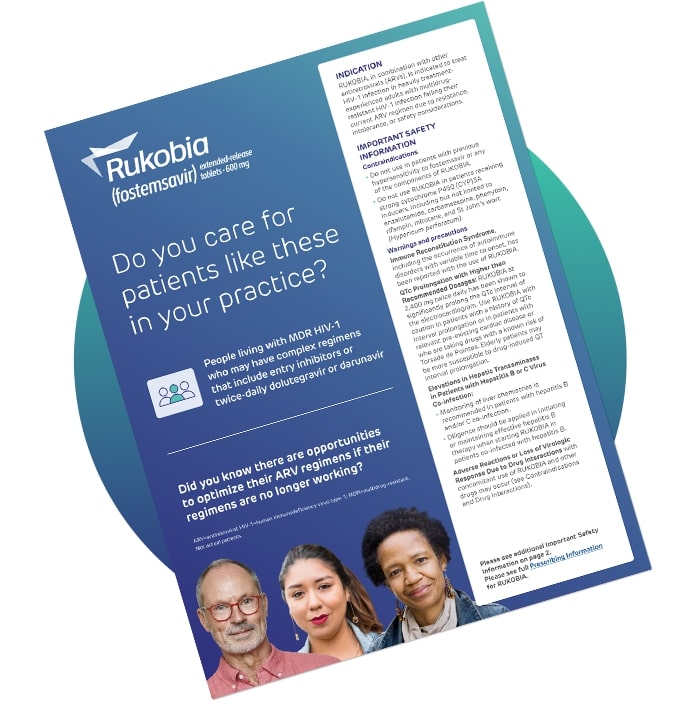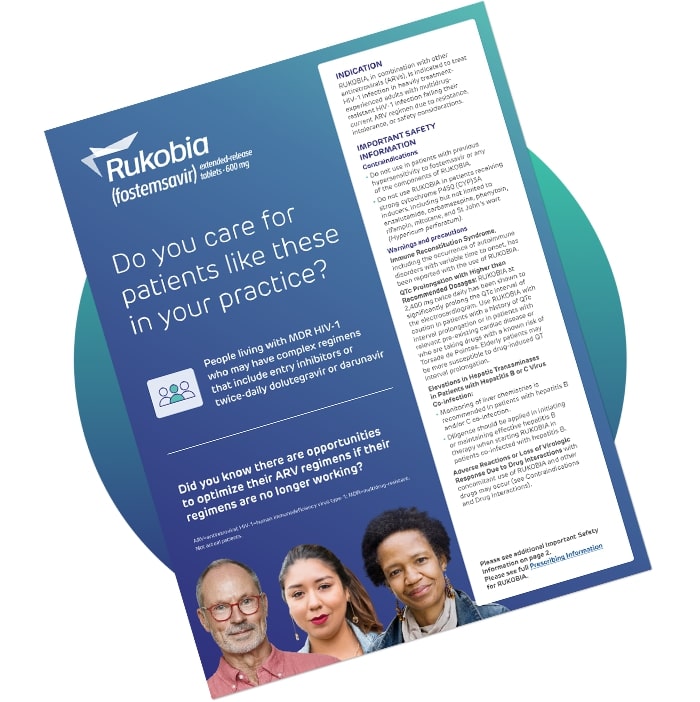VISUAL
Video opens on copy and logo that animates and morphs onto the screen. ISI tray with Indication scrolls at the bottom of the screen after image and copy morph
SUPER
People living with multidrug-resistant (MDR) HIV-1 have unique journeys and wide-ranging treatment concerns1
[RUKOBIA logo]
Images are not real patients.
HIV-1=human immunodeficiency virus type-1.
INDICATION
RUKOBIA, in combination with other antiretrovirals (ARVs), is indicated to treat HIV-1 infection in heavily treatment-experienced adults with multidrug-resistant HIV-1 infection failing their current ARV regimen due to resistance, intolerance, or safety considerations.
GLOBAL MUSIC
Low music in background
VISUAL
Copy morphs in line by line
SUPER
People living with multidrug-resistant (MDR) HIV-1 have unique journeys and wide-ranging treatment concerns1
[RUKOBIA logo]
Images are not real patients.
HIV-1=human immunodeficiency virus type-1.
IMPORTANT SAFETY INFORMATION
Contraindications
- Do not use in patients with previous hypersensitivity to fostemsavir or any of the components of RUKOBIA.
GLOBAL MUSIC
Low music in background
VISUAL
Video opens on copy that animates and morphs onto the screen. ISI tray with Important Safety Information scrolls at the bottom of the screen after image and copy morph
SUPER
Take a different look at MDR HIV-1
- Do not use RUKOBIA in patients receiving strong cytochrome P450 (CYP)3A inducers, including but not limited to enzalutamide, carbamazepine, phenytoin, rifampin, mitotane, and St John’s wort (Hypericum perforatum).
Please see additional Important Safety Information for RUKOBIA later in the video.
GLOBAL MUSIC
Low music in background
VISUAL
Video opens on copy that animates and morphs onto the screen. ISI tray with Important Safety Information scrolls at the bottom of the screen after image and copy morph
SUPER
Take a different look at MDR HIV-1
Please see additional Important Safety Information for RUKOBIA later in the video. Please click the link on this page to view the full Prescribing Information for RUKOBIA.
GLOBAL MUSIC
Low music in background
VISUAL
Video transitions through all patient images
GLOBAL MUSIC
Low music in background
VISUAL
Patient image slides to the left of the frame as copy morphs onto the screen
SUPER
“I’m feeling anxious because I’m running out of options. I’m wondering if there’s an ARV regimen out there that could help me.”
– Jonathan
ARV=antiretroviral.
GLOBAL MUSIC
Low music in background
VISUAL
Copy fades and new copy appears onscreen
SUPER
People living with MDR HIV-1
May be long-term survivors who are living with the prospect of running out of treatment options1,2
GLOBAL MUSIC
Low music in background
VISUAL
Video transitions through all patient images
GLOBAL MUSIC
Low music in background
VISUAL
Video lands on an image of Sherry. Copy morphs onto the screen
SUPER
“I’m worried about my long-term health because my current HIV treatment is not working for me, and I’m nervous about opportunistic infections.”
– Sherry
GLOBAL MUSIC
Low music in background
VISUAL
Text fades. New copy appears onscreen
SUPER
People living with MDR HIV-1
May be concerned about ongoing viremia and the associated health risks1,3,4
GLOBAL MUSIC
Low music in background
VISUAL
Sherry moves to the right side of the screen and wipes away copy
SUPER
People living with MDR HIV-1
May be concerned about ongoing viremia and the associated health risks1,3,4
GLOBAL MUSIC
Low music in background
VISUAL
Video transitions through all patient images
GLOBAL MUSIC
Low music in background
VISUAL
Quote morphs onto the screen
SUPER
“I am experiencing side effects with my HIV medication. Is there another option out there for me?”
– Anna
GLOBAL MUSIC
Low music in background
VISUAL
Copy fades and new copy morphs onto the screen
SUPER
People living with MDR HIV-1
May feel that they have to manage the side effects that come with their ARV options2
GLOBAL MUSIC
Low music in background
VISUAL
Video transitions through all patient images
GLOBAL MUSIC
Low music in background
VISUAL
Morph lands on William and quote appears onscreen
SUPER
“Due to a recent diagnosis, I need new medication. I’m worried how this may impact my current ARV regimen.”
– William
GLOBAL MUSIC
Low music in background
VISUAL
Quote fades and new copy appears onscreen
SUPER
People living with MDR HIV-1
May need an ARV option with a different drug-drug interaction profile2
Please see the full Prescribing Information for RUKOBIA for additional information about drug-drug interactions.
GLOBAL MUSIC
Low music in background
VISUAL
Video transitions through all patient images
GLOBAL MUSIC
Low music in background
VISUAL
Morph lands on Jennifer and quote appears onscreen
SUPER
“I did not consistently take my medications in the past, but now I am committed to taking my treatment, as my doctor prescribes, to suppress the virus.”
– Jennifer
GLOBAL MUSIC
Low music in background
VISUAL
Quote fades and is replaced by new copy
SUPER
People living with MDR HIV-1
May need another ARV option that works with their current oral dosing schedule RUKOBIA is one 600-mg tablet taken orally twice daily with or without food.
GLOBAL MUSIC
Low music in background
VISUAL
Jennifer moves to the center of the frame and copy disappears
GLOBAL MUSIC
Low music in background
VISUAL
Video transitions through all patient images
GLOBAL MUSIC
Low music in background
VISUAL
Copy appears onscreen
SUPER
See what may be possible with RUKOBIA
GLOBAL MUSIC
Low music in background
VISUAL
Text animates and morphs onto the screen
SUPER
RUKOBIA is a first-in-class attachment inhibitor specifically developed for people living with MDR HIV-1
GLOBAL MUSIC
Low music in background
VISUAL
Copy and GIF fade and are replaced by new copy. Then logo animates onto the screen
SUPER
An option when a change is needed in their regimen
[RUKOBIA logo]
MUSIC
Music fades out
GLOBAL MUSIC
Low music in background
VISUAL
Copy morphs in and scrolls up
SUPER
IMPORTANT SAFETY INFORMATION (cont’d)
Warnings and precautions
Immune Reconstitution Syndrome, including the occurrence of autoimmune disorders with variable time to onset, has been reported with the use of RUKOBIA.
QTc Prolongation with Higher than Recommended Dosages: RUKOBIA at 2,400 mg twice daily has been shown to significantly prolong the QTc interval of the electrocardiogram. Use RUKOBIA with caution in patients with a history of QTc interval prolongation or in patients with relevant pre-existing cardiac disease or who are taking drugs with a known risk of Torsade de Pointes. Elderly patients may be more susceptible to drug-induced QT interval prolongation.
Elevations in Hepatic Transaminases in Patients with Hepatitis B or C Virus Co-infection:
- Monitoring of liver chemistries is recommended in patients with hepatitis B and/or C co-infection.
- Diligence should be applied in initiating or maintaining effective hepatitis B therapy when starting RUKOBIA in patients co-infected with hepatitis B.
Adverse Reactions or Loss of Virologic Response Due to Drug Interactions with concomitant use of RUKOBIA and other drugs may occur (see Contraindications and Drug Interactions).
Adverse reactions
- The most common adverse reaction (all grades, randomized cohort) observed in ≥5% of subjects was nausea (10%).
- 81% of adverse reactions reported with RUKOBIA were mild or moderate in severity.
Drug interactions
- See the full Prescribing Information for RUKOBIA for a complete list of significant drug interactions.
- Temsavir may increase plasma concentrations of grazoprevir and voxilaprevir. Use an alternative hepatitis C virus regimen if possible.
- Use the lowest possible starting dose for statins and monitor for statin-associated adverse events.
- Patients receiving RUKOBIA should not take doses of estrogen-based therapies, including oral contraceptives, that contain more than 30 mcg/day of ethinyl estradiol. Caution is advised particularly in patients with additional risk factors for thromboembolic events.
Use in specific populations
- Pregnancy: There are insufficient human data on the use of RUKOBIA during pregnancy to definitively assess a drug-associated risk for birth defects and miscarriage. An Antiretroviral Pregnancy Registry has been established.
- Lactation: Breastfeeding is not recommended due to the potential for HIV-1 transmission, developing viral resistance, and adverse reactions in a breastfed infant.
Please see additional Important Safety Information for RUKOBIA at the beginning of this video. Please click the link on this page to view the full Prescribing Information for RUKOBIA.
GLOBAL MUSIC
Low music in background
VISUAL
Logo and copy fade in
SUPER REFERENCES:
- Ackerman P, Thompson M, Molina JM, et al. Long-term efficacy and safety of fostemsavir among subgroups of heavily treatment-experienced adults with HIV-1. AIDS. 2021;35(7):1061-1072.
- Pelchen-Matthews A, Borges AH, Reekie J, et al. Prevalence and outcomes for heavily treatment-experienced individuals living with human immunodeficiency virus in a European cohort. J Acquir Immune Defic Syndr. 2021;87(2):806-817.
- Achhra A, Amin J, Law M, et al. Immunodeficiency and the risk of serious clinical endpoints in a well-studied cohort of treated HIV-infected patients. AIDS. 2010;24(12):1877-1886.
- Engsig F, Zangerle R, Katsarou O, et al. Long-term mortality in HIV-positive individuals virally suppressed for >3 years with incomplete CD4 recovery. Clin Infect Dis. 2014;58(9):1312-1321.
ViiV logo
Trademarks are owned by or licensed to the ViiV Healthcare group of companies. ©2022 ViiV Healthcare or licensor.
FSTVID220012 August 2022
Produced in USA.
GLOBAL MUSIC
Low music in background
Resistance, tolerability, or safety concerns may require a regimen change for some patients
RUKOBIA is the first-in-class attachment inhibitor specifically developed for people living with MDR HIV-1.
People living with MDR HIV-1 are a diverse group. Each has a unique journey but shares similar needs for:
- Durable virologic suppression
- CD4+ T-cell recovery


65 years old
Diagnosed 23 years ago
“I’m feeling anxious because I’m running out of options and wondering if there’s an ARV regimen out there that could help me.”
People living with MDR HIV-1 may be long-term survivors who are living with the prospect of running out of treatment options.2


49 years old
Diagnosed 20 years ago
“I'm worried about my long-term health because my current HIV-1 treatment is not working for me, and I'm nervous about opportunistic infections.”
People living with MDR HIV-1 may be concerned about ongoing viremia and the associated health risks.3


29 years old
Diagnosed 15 years ago
“I am experiencing side effects with my HIV-1 medication. Is there another option out there for me?”
People living with MDR HIV-1 may feel that they have to manage the side effects that come with their ARV options.4


59 years old
Diagnosed 27 years ago
“Due to a recent diagnosis, I need new medication. I'm worried how this may impact my current ARV regimen.”
People living with MDR HIV-1 may need an ARV option with a different drug-drug interaction profile.4
Real-life stories of people living with MDR HIV-1
James, living with HIV. Individual results may vary. Compensated by ViiV Healthcare.
VO: My name is James. I’m a heavily treatment-experienced person living with HIV. I’m a pastor of a local church.
VIDEO: B-Roll Footage: James entering the Masonic.
VO: I first learned about my HIV diagnosis in the ‘80s. I had a pain in the lower part of my back, and so I went to my primary care doctor and, uh, while I was there, you know, then he said to me, he said, “James, I think you need to get an HIV test.” I said, “Why do you think I need an HIV test?” He said, “Well, because of your lifestyle.”
VIDEO: Video portrait, James sitting in chair.
SUPER: James, living with HIV. Compensated by ViiV Healthcare.
VO: When I came back two weeks later for my results, then he informed me at that time that I was HIV positive. I refused to believe that it was my test.
VIDEO: Interview Footage–Camera B.
VO: I know that if I admitted that I was HIV positive, at the same time I’d have to, uh, admit to the fact that I was gay. My father was so vehemently against, uh, anybody who was gay. There was one time my, my youngest brother he said, you know, uh, “I want you to know,” he said, “I have a problem with people who are gay.”
VIDEO: B-Roll Footage: James alone at waterfront.
VO: When you hear those kind of statements and you begin to think, “When it comes time and everybody begins to find out, they’ll begin to push away from me,” and I don’t want that to happen. So I won’t say anything to anybody. Instead of dealing with life on life’s terms, you know, I used the drugs and the alcohol to escape.
VIDEO: B-Roll Footage: James alone at waterfront.
VO: My experience with various treatment medications was really challenging. For several years, the side effects were always so tremendous, which caused me not to be adherent to the medications.
VIDEO: Interview Footage–Camera B.
VO: I have experienced some of those side effects, especially, uh, the nauseousness, gastrointestinal situations, where I couldn’t tolerate to ingest any kind of food or water, along with loose bowels, going to the bathroom constantly.
VIDEO: Macro shots of James’ hands.
VO: I had an incident with my youngest sister. She developed, uh, HIV. And my mother called me and said, “We need to go and see your sister, uh, in the hospital.” And when we went to see her, I stayed on the outside because when I looked at her, I was looking at my own self.
VIDEO: B-Roll Footage: James alone at waterfront.
VO: Maybe about a year later, I went to the hospital and when I got to the door of her room, she looked up at me. She say, “You weren’t here for me, get outta here.”
VIDEO: B-Roll Footage: James alone at waterfront.
VO: That was a turning point. I had to come out of denial and be in acceptance of what was going on with me in order to be able to be there for somebody else.
VIDEO: Interview Footage–Camera A.
VO: The first thing that I started doing was being adherent, uh, to the medications that were given to me. I was on three medications that I began to feel okay with and not have a lot of tremendous side effects. Uh, but, uh, after a while, I discovered that those medications weren’t working for me.
VIDEO: B-Roll Footage: café environment.
VO: Because of me not being adherent early on, I became resistant to certain medications.
VIDEO: Interview Footage–Camera B.
VO: My T-cells were lessening and my viral load was replicating. And then, of course, the opportunistic infections began to happen. I had the pneumonia pneumocystis. I couldn’t take 10 steps and get my breath. It was so painful and at the same time being painful, it was also frightening. I went into the emergency room.
VIDEO: B-Roll Footage: café environment.
VO: One of the nurses that’s a part of our congregation, she came to the ER. She just said to me, “James, uh, I’m here for you.” And that was a first time that I had anybody to let me know that they were there and I could trust them.
VIDEO: B-Roll Footage: James in café.
VO: After that was when I began to share with my mother and my brothers and my sisters. They said, “You’re our brother, and whatever we need to do in order to help you.” And it was just unbelievable to me. It was important from the standpoint that it made me be okay with myself. And it mean that I did not have to hide.
VIDEO: B-Roll Footage: Calvin hugging James in café.
VO: The way I feel now with my diagnosis is that I have a great deal of hopefulness. I just have to keep positive knowing that things are going to get better.
VIDEO: B-Roll Footage: James gazes contemplatively.
VIDEO: Reference block.
VIDEO: ViiV LOGO.
SUPERS: Trademarks are owned by or licensed to the ViiV Healthcare group of companies. ©2021 ViiV Healthcare or licensor. FSTVID200017 February 2021 Produced in USA.
Dennis, living with HIV and taking RUKOBIA. Individual results may vary. Compensated by ViiV Healthcare.
VO: Indication. RUKOBIA, used with other antiretrovirals, is indicated for heavily treatment-experienced adults with multidrug-resistant HIV-1 who are failing their current ARV regimen. Important Safety Information. Contraindications. Do not use in patients with previous hypersensitivity to fostemsavir or any of the components of RUKOBIA. Do not use RUKOBIA in patients receiving strong cytochrome P450 (CYP)3A inducers, including those listed here. Please see additional Important Safety Information for RUKOBIA at the end of the video. Please use the link on this page to view the full Prescribing Information for RUKOBIA.
VIDEO: Indication, ISI.
VO: My name is Dennis. I’m married and I live with my husband and our two dogs and a cat. I’m a heavily treatment-experienced person living with HIV.
VIDEO: B-Roll, Vineyard. Dennis walking toward the camera, his face obscured by the sun flare.
SUPER: The testimonial in this video is from a person living with HIV-1 sharing his personal experience about his diagnosis and his treatment with RUKOBIA. Individual results may vary.
VO: I was diagnosed with HIV in 1991. When I first received the diagnosis, I was upset. It was kind of a scary time. Back in those days, it was still very much something people thought you should be ashamed of.
VIDEO: B-Roll, Interview Camera A: Dennis taking an inhale, then releasing a deep exhale.
SUPER: Dennis, taking RUKOBIA as part of an HIV-1 regimen. Compensated by ViiV Healthcare.
VO: And I waited almost a year before I sought medical treatment. VIDEO: B-Roll, Interview Camera A.
VO: I think what was so difficult with adherence in the beginning is, um, I was still feeling a little bit of stigma. And also, the side effects were sometimes intolerable. I knew if could I take these pills, I’m gonna feel like I have a hangover all over again. So I wouldn’t.
VIDEO: Macro-shots of Dennis’ hands/gestures to express tension.
VO: I became, you know, serious and really consistent with treatment after I had a bout with toxoplasmosis in 1998.
VIDEO: Interview Footage—Camera B.
VO: My friend found me on the floor. I had passed out.
VIDEO: Screen quickly cuts to black.
VO: A couple days later is when I came to in the hospital.
VIDEO: Slowly fade in from black as “came to” VO plays; light peers through leaves in the wind.
VO: And that really, um, shook me. After I got out of the hospital I vowed I would never go back to that place again.
VIDEO: Interview Footage—Camera A.
VO: The minor challenges in the last, you know, I would say ten years, have always been when I started having treatment failure. And at times, you know, it was very frustrating because you’d be taking your meds, but you would still develop resistance. They would be kind of low points until I would talk to my doctor.
VIDEO: B-Roll, Tower Bridge: Dennis and Marcos shot from the front.
VO: We would just switch to, um, another regimen. And then 12 months, 14 months, 18 months in, we would start seeing virus again in the blood.
VIDEO: B-Roll, Tower Bridge: Dennis and Marcos pensively gazing into the distance, Dennis in focus.
VO: I have resistance to multiple classes of medication, but I’ve never given up. I’m always looking for the, that next thing that can help me.
VIDEO: Macro-shots of Dennis’ hands/gestures.
VO: The last regimen I was taking, I was starting to see more virus. The viral load had kept going up, and it was to the level where we didn’t want it. But I was thinking what am I gonna do?
VIDEO: B-Roll, Tower Bridge, Dennis in focus.
VO: My doctor said, “There’s a medication that’s in clinical trials.” Finding out that there was a medication like RUKOBIA. I had a great hope that this medication when added to others would help get me back down.
VIDEO: Interview Footage—Camera B. RUKOBIA logo appears on screen at first mention.
VO: So when I went into the study, the doctor at the study site was, uh, collaborating with other HIV experts around getting a regimen that would work for me and my multiple resistance.
VIDEO: Interview Footage—Camera A.
VO: RUKOBIA, in conjunction with the other antiretrovirals I’m taking, got me to undetectable.
VIDEO: B-Roll, Picnic: Dennis taking photographs.
SUPER: Not all patients who have taken RUKOBIA as part of an HIV-1 regimen reached undetectable.
VO: I have, uh, so many things to feel grateful for. I have a great support system around me and a husband who loves and supports me, um, and I can love and support back. I feel really confident. In the beginning, I wasn’t, and that’s natural. I’ve learned a few things, you can go on with the other things in your life that you want, and are meant, to do.
VIDEO: B-Roll Footage, Picnic, Vineyard.
VIDEO: Supporting data appears on screen.
SUPER/VO: BRIGHTE is a Phase 3, partially randomized trial in HTE patients with confirmed HIV-1 RNA greater than or equal to 400 copies per milliliter. The randomized cohort (double-blind, placebo-controlled through Day 8, then open-label through Week 96) enrolled 272 patients who had 1 or 2 ARV classes remaining due to resistance, intolerability, or contraindications.
The primary endpoint was based on the adjusted mean decline in HIV-1 RNA from Day 1 to Day 8 in the randomized cohort. RUKOBIA met the primary endpoint by achieving a statistically significant viral load reduction of 0.79 log10 compared to 0.17 log10 with placebo at Day 8.
As a secondary endpoint, BRIGHTE assessed the proportion of randomized patients who achieved virologic suppression with RUKOBIA + OBT, defined as a viral load of less than 40 copies per milliliter. At Week 96, 60% of patients achieved virologic suppression with RUKOBIA + OBT, an increase from 53% at Week 24. The FDA Snapshot Algorithm was used, in which patients who had missing HIV-1 RNA values or who changed the composition of their optimized background therapy were classified as having had virologic failure.
VO: The most common adverse reactions, all grades, observed in greater than or equal to 4% of patients in the randomized cohort were nausea, diarrhea, and headache.
VIDEO: AE Table fades on screen.
VO: Important Safety Information, continued. Warnings and Precautions. Immune Reconstitution Syndrome and autoimmune disorders have been reported with the use of RUKOBIA. QTc prolongation has occurred with higher than recommended dosages of RUKOBIA. Use RUKOBIA with caution in patients with a history of QTc interval prolongation or cardiac disease, or who are taking drugs with a known risk of Torsade de Pointes. Elderly patients may be more susceptible. Monitoring of liver chemistries is recommended in patients with hepatitis B and/or C co-infection. Diligence should be applied when starting RUKOBIA in patients receiving hepatitis B therapy. Adverse reactions or loss of virologic response due to drug interactions may occur when using RUKOBIA with other drugs. Adverse Reactions. The most common adverse reaction reported with RUKOBIA was nausea. Drug Interactions. See the full Prescribing Information for RUKOBIA for all significant drug interactions.
VIDEO: HCP Important Safety Information scrolls.
VO: Temsavir may increase plasma concentrations of grazoprevir and voxilaprevir. Use an alternative hepatitis C virus regimen, if possible. Use the lowest possible starting dose for statins with careful monitoring. Patients receiving RUKOBIA should not take estrogen-based therapies that contain more than 30 micrograms per day of ethinyl estradiol.
Use RUKOBIA with caution in patients with additional risk factors for thromboembolic events. Use in Specific Populations. There are insufficient data on the use of RUKOBIA during pregnancy to assess drug-associated risks. Breastfeeding is not recommended in patients with HIV-1. Please use the link on this page to view the full Prescribing Information for RUKOBIA.
VIDEO: HCP Important Safety Information scrolls.
VIDEO: Reference block fades on screen.
VIDEO: RUKOBIA AND ViiV LOGOS.
SUPERS: Please use the link on this page to view the full Prescribing Information for RUKOBIA. Trademarks are owned by or licensed to the ViiV Healthcare group of companies. ©2021 ViiV Healthcare or licensor. FSTVID200016 April 2021 Produced in USA.
ARV=antiretroviral; MDR=multidrug-resistant; HIV-1=human immunodeficiency virus type-1.
References:
- Aberg JA, Shepherd B, Wang M, et al. Week 240 efficacy and safety of fostemsavir plus optimized background therapy in heavily treatment-experienced adults with HIV-1. Infect Dis Ther. 2023;12(9):2321-2335. doi:10.1007/s40121-023-00870-6
- Ackerman P, Thompson M, Molina JM, et al. Long-term efficacy and safety of fostemsavir among subgroups of heavily treatment-experienced adults with HIV-1. AIDS. 2021;35(7):1061-1072.
- Pelchen-Matthews A, Borges AH, Reekie J, et al. Prevalence and outcomes for heavily treatment-experienced individuals living with human immunodeficiency virus in a European cohort. J Acquir Immune Defic Syndr. 2021;87(2):806-817.
- Lataillade M, Lalezari JP, Kozal M, et al. Safety and efficacy of the HIV-1 attachment inhibitor prodrug fostemsavir in heavily treatment-experienced individuals: week 96 results of the phase 3 BRIGHTE study. Lancet HIV. 2020;7(11):740-751.
FSTWCNT230023



